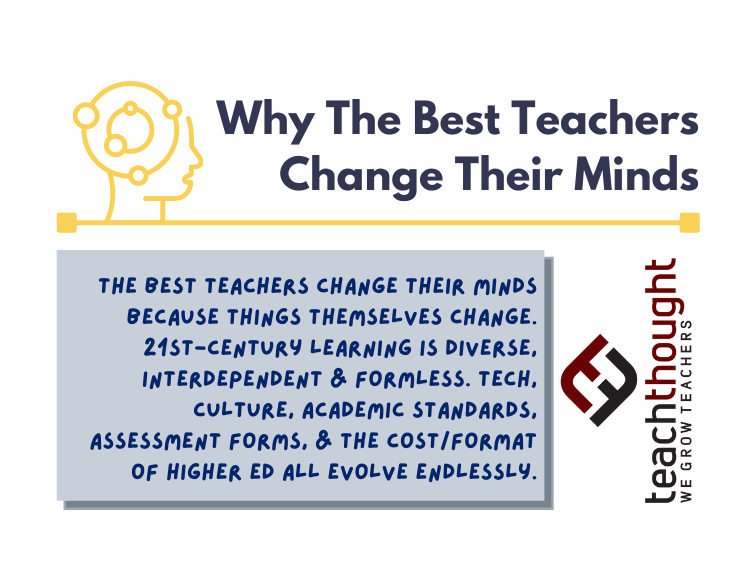
The Best Teachers Change Their Minds
by Terry Heick
When I first started teaching, I thought essay writing was the ideal form of assessment for most academic learning.
If students could ‘write intelligently’ about an idea (or the big idea of a certain academic standard), they understood. If they struggled, they probably didn’t—and that struggle was on full display in the essay, which made it easier to highlight, conference with students, and plan future learning experiences.
Essays were (mostly) easy to grade, rubrics were simple to create, and the best examples could be hung on walls or saved for student portfolios. After all, writing essays was how it was done in my high school and college coursework, and I turned out okay. But it didn’t take long for me to see that the writing process –the craft of writing—got in the way of students communicating their understanding of specific academic content. Rather than a template for emptying thinking, for many students, the writing process was a barrier to that kind of transparency.
The same change of heart applies to whole-class direct instruction. In lieu of everything I read and was told, it seemed to work in my classroom. Whether a brief mini-lesson modeling how to do something or a full-on 15-minute lecture, students responded to direct instruction and seemed to be able to explain in greater detail what they understood.
It also fits with the school’s practice of very specific and clear learning targets and allowed me to build strong relationships with students, which would pay dividends as the year went on. My opinions on both writing-as-assessment and direct instruction were both based on a limited amount of experience. Or rather, almost none. So it makes sense that by my third year of teaching, I had abandoned essays as the ultimate assessment tool, and had delegated whole class direct instruction to literally timed sessions that were complete with QFT sessions and student questioning—more accountable talk than lecture.
Somewhere in your tool belt of teacher tools, there is something you cling to that may be wrong-headed, but you don’t see it yet. And that’s okay.
In many ways, there is no ‘right’ or ‘wrong’ but only degrees of fit and subjectivity. If you’re changing your mind—about the role of technology in learning, the ideal lesson template, or the best audiences for project-based learning products—that means you’re growing.
You’re reacting to formal and informal data in front of you every day. Anecdotal data, parent conferences, literacy rates, test scores, and a thousand other points. You’re responding to the progression of technology in the world around you.
You’re changing to meet the needs of a new generation of students whose natural skills and interests seem to tend towards project-based learning.
You see the cognitive rigor of video games and simulations and you wonder if game-based learning might have a place–if even a small place–in the classroom you share with students. (You no longer call it ‘your’ classroom.)
The best teachers change their minds because things themselves change. 21st-century learning is, above all else, diverse, interdependent, and formless. Technology, culture, academic standards, assessment forms, and the cost–and format–of higher education all evolve endlessly.
This means, as their most powerful common mediator, you have to as well.
